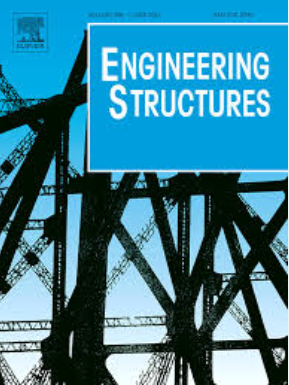全尺寸AASHTO型I型不锈钢预应力梁的受弯性能
IF 6.4
1区 工程技术
Q1 ENGINEERING, CIVIL
引用次数: 0
摘要
与其他耐腐蚀材料相比,不锈钢正在成为桥梁建设中抗腐蚀的有前途的替代品。由于高强度不锈钢(HSSS)钢绞线的极限应变与传统碳钢(CS)钢绞线相比有限,因此在CS钢绞线中观察到的屈服-通常伴随着混凝土在极限压缩纤维处的破碎-可能不会发生在HSSS钢绞线中。为此,本文提供了一项研究的结果,调查了在理解使用HSSS股预应力混凝土梁的抗弯行为方面的差距。四个全尺寸12 m(39.5 ft)长的AASHTO I型梁使用15.75 mm(0.62 in.)双工2205 HSSS股被设计,制造,并在四点弯曲下测试。实验程序考虑了不同的变量,如股数,预应力水平,以及加载类型,包括单调和疲劳加载。由于有限的极限应变在HSSS,设计考虑断裂的股在极限作为一个经济的解决方案。然而,尽管设计考虑了钢绞线断裂,但低于混凝土强度(低于规定值)导致两根梁出现混凝土破碎破坏。然而,所有的梁都表现出令人满意的性能,表现出显著的预留挠度和足够的强度。经历钢绞线断裂的梁在失效前显示出明显的警告信号,如广泛的开裂和明显的挠曲。随后,由于所有钢绞线的断裂,出现了更大的裂缝开口。基于应变协调原理的分析模型被用于预测弯曲行为,并与实验数据进行了验证。此外,采用修正矩形应力块参数的数值模型对不锈钢预应力混凝土梁的名义弯矩强度进行了评估。两个模型的结果与实验结果非常吻合。本文章由计算机程序翻译,如有差异,请以英文原文为准。
Flexural behavior of full-scale AASHTO type I girders prestressed with stainless steel strands
Stainless steel is becoming a promising alternative for bridge construction to combat corrosion compared to other corrosion-resistant materials. Due to the limited ultimate strain of High-Strength Stainless Steel (HSSS) strands compared to conventional carbon steel (CS) strands, the yielding observed in CS strands—usually followed by concrete crushing at the extreme compression fiber—may not occur with HSSS strands. For this purpose, this paper provides the results of a study investigating the gap in understanding the flexural behavior of prestressed concrete girders using HSSS strands. Four full-scale 12 m (39.5 ft) long AASHTO Type I girders using the 15.75 mm (0.62 in.) duplex 2205 HSSS strands were designed, fabricated, and tested under four-point bending. The experimental program considered different variables, such as the number of strands, prestressing levels, and the type of loading applied, including monotonic and fatigue loading. Due to limited ultimate strains in HSSS, the design considered rupture of the strands at ultimate as an economical solution. However, despite design considerations for strand rupture, lower concrete strength (than the specified value) led to two girders exhibiting concrete crushing failure. Nevertheless, all girders demonstrated satisfactory performance, exhibiting significant reserve deflection and adequate strength. The girders experiencing strand rupture showed clear warning signs, such as extensive cracking and significant deflection before failure. This was followed by larger crack openings ultimately due to the rupture of all the strands. An analytical model based on strain compatibility principles was used and validated against experimental data to predict flexural behavior. Furthermore, a numerical model utilizing modified rectangular stress block parameters was employed to assess the nominal moment strength of stainless steel prestressed concrete girders. The results from both models closely matched the experimental findings.
求助全文
通过发布文献求助,成功后即可免费获取论文全文。
去求助
来源期刊

Engineering Structures
工程技术-工程:土木
CiteScore
10.20
自引率
14.50%
发文量
1385
审稿时长
67 days
期刊介绍:
Engineering Structures provides a forum for a broad blend of scientific and technical papers to reflect the evolving needs of the structural engineering and structural mechanics communities. Particularly welcome are contributions dealing with applications of structural engineering and mechanics principles in all areas of technology. The journal aspires to a broad and integrated coverage of the effects of dynamic loadings and of the modelling techniques whereby the structural response to these loadings may be computed.
The scope of Engineering Structures encompasses, but is not restricted to, the following areas: infrastructure engineering; earthquake engineering; structure-fluid-soil interaction; wind engineering; fire engineering; blast engineering; structural reliability/stability; life assessment/integrity; structural health monitoring; multi-hazard engineering; structural dynamics; optimization; expert systems; experimental modelling; performance-based design; multiscale analysis; value engineering.
Topics of interest include: tall buildings; innovative structures; environmentally responsive structures; bridges; stadiums; commercial and public buildings; transmission towers; television and telecommunication masts; foldable structures; cooling towers; plates and shells; suspension structures; protective structures; smart structures; nuclear reactors; dams; pressure vessels; pipelines; tunnels.
Engineering Structures also publishes review articles, short communications and discussions, book reviews, and a diary on international events related to any aspect of structural engineering.
 求助内容:
求助内容: 应助结果提醒方式:
应助结果提醒方式:


